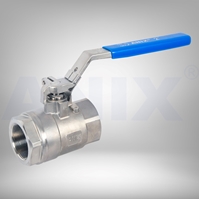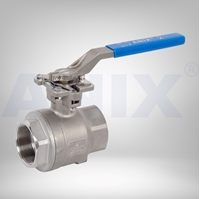Ball Valve
ANIX ball valves manufactured and distributed by ANIX Valve USA are made of Cast steel, CF8M stainless steel, 316 Stainless steel, Forged steel and WCB carbon steel material which include 3 way threaded ball valve, mini ball valve, 2-pieces, 3-pieces Threaded Ball Valve 1000, 2000 and 3000 WOG/ PSI Socket Weld ball valve, Butt Weld ball valve, Clamped end ball valve, 2 piece Flanged ball valve with fire safe, floating ball, 3 way Flanged ball valve and Trunnion Mounted ball valve Class 150, Class 300, Class 600 available.
Summary of ball valves
A ball valve operates by using a rounded plug called a "ball" to seal against another opening with either no flow or limited flow. It consists of a cylindrical body with a U-shaped opening at one end and a plunger-type arm at the other. When the plunger is depressed, the flow of fluid is restricted. There are various sizes of balls which limit the diameter of the fluid channel that can pass through the valve. The opening in the housing provides a cylindrical chamber where the ball can rotate. If there are multiple planes inside the ball, then the fluid must pass through several openings.
How do they work?
Inside each ball there is an annular gap that serves as a place for the liquid to flow around when it exits the valve. The width of these gaps serve two purposes; first, they ensure adequate sealing by the edge of the solid ring welded onto the surface; second, they help determine how much control you have over which direction the water flows. When pressure is applied to the smaller sphere, it causes it to move up and down in the larger sphere. This movement changes the pressure inside the smaller sphere, which changes fluid flow through the valve.
The disk-shaped (or other element) sits within the pipe, host component, or fitting containing the port or hole, is typically made from rigid material, and forms one end of a clearance chamber. On every stroke, the ball partially blocks the passage, allowing only some fluid to enter the clearance space. On each succeeding stroke, more fluid enters this clearancing space from the main body of fluid flowing in the line, minimizing blockage. By blocking off part of the fluid path, the valves minimize pressure drop and friction loss.
Various Applications of Ball Valves
In addition to controlling gas flows, ball valves are popular in many home/commercial applications and across many industries; such as plumbing in homes to oil pipelines in commercial facilities. Placing a valve anywhere along a pipeline is an effective way to stop flow while maintaining pressure. They are often used in water systems to control water levels in tanks and pipes, and in air conditioning and refrigeration systems to control the flow of air and refrigerant. It is particularly common in plumbing applications, where it restricts or permits water, oil, gas, or steam flow.
Ball valves can be used as stop valves to control water flow in streams, rivers, and other bodies of water. Second, ball valves can assist with setting the water pressure in plumbing systems. Third, ball valves can switch between two water sources (for example, when one is running low). Finally, ball valves can be used to adjust the temperature of water supplies.
By restricting flow, you restrict the possibility of water hammering (impact) during system repairs. Also, if there is risk of hydrocarbon leaks, such as in petroleum systems, using a ball valve may be more suitable than relying only on flaring pipes or fittings.
Reasons for using Ball Valves
Ball valves are easy to use. Most have simple controls that let you open or close the valve quickly and easily. They are also very versatile and can be used in various applications, including water supplies, pipelines, and drainage systems. Reliability is also one aspect of ball valves, as they are built to last and typically have warranties covering their defects. Finally, ball valves are energy-saving devices. They use less energy than other types of valves, saving you money in the long run.

























